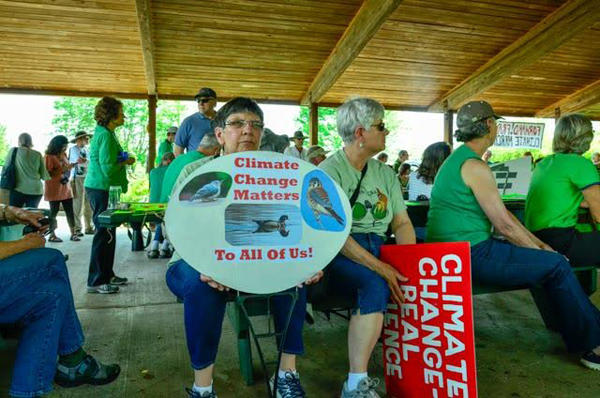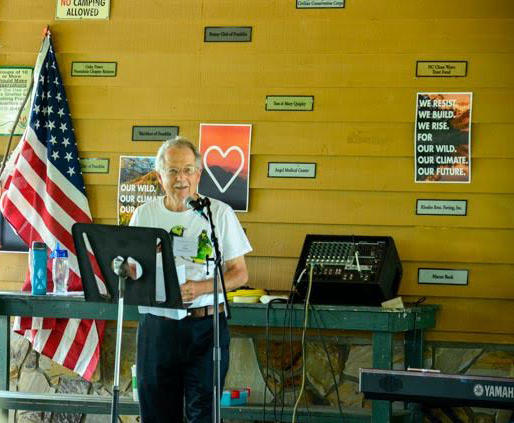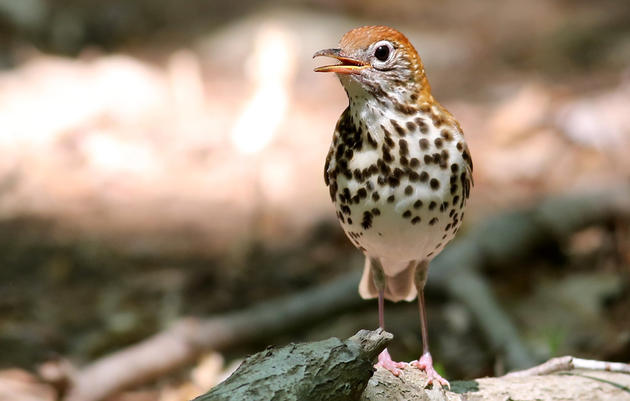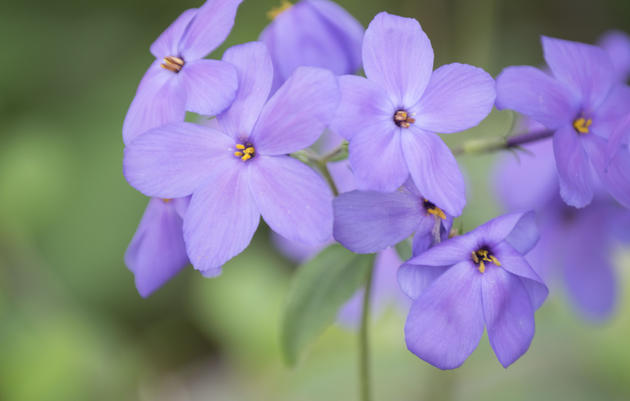Tom spoke in detail about the effects of climate change on our local birds, and brought our North Carolina birds to life with song.
The full text of Tom's inspirational speech is below, as are links to the songs of the birds he marched to support.

Climate March Speech
Franklin, NC
Apr 29, 2017
The other speakers have talked about the impact of climate change on humans. I going to talk about the impact of climate change on the creatures with whom we share the earth – specifically birds.
In 2014, National Audubon Society released a science study on birds and climate change. The report was 7 years in the making and used data dating back 50 years. The report confirmed that climate change is the single greatest threat to North American birds.
Many years ago Emily Dickinson wrote, “Hope is the thing with feathers.”
But Audubon’s report on birds and climate change is not hopeful. Of the 588 species of North American birds studied, 314 species are severely threatened by global warning. Many could lose more than half of their current climate ranges by 2050 – which is within the lifetime of your children and grandchildren. Only 9 bird species have gone extinct since Europeans landed in North America - many more could go extinct if we do not act.
Every bird species has a “tolerance zone” for climate conditions – similar to garden tolerance zones. If the climate gets too hot, too cold, too wet or too dry, birds cannot successfully raise their babies.
Yes, birds can fly. They can more north or inland or to higher elevations. And indeed over the last 50 years, the data shows that more than 60% of wintering North American bird species have shifted their winter range northward.
But much like people, birds are imprinted on the place they were born. Our migrants are going to return to their home and our resident birds are going to try to raise their babies where they were raised. By the time they try to move it may be too late. Will the climate conditions be what they need?
And simply flying north or inland is often not a solution. Human development limits their opportunities and for many birds the right habitat is simply not available. Many of our own local warblers and other beloved mountain breeders, will be unable to move any higher in elevation. The Golden-crowned Kinglets at Mount Pisgah cannot move any higher.
Let me mention a few birds – ones I hope you know.
- Wood Thrush– Many of you may never see the Wood Thrush but I hope you have heard its beautiful, plaintive song. Three years ago a Wood thrush was captured in a mist net just north of Winston-Salem and fitted with a tracking device. Remarkably the bird was recaptured one year later within 200 yards of the same spot. The data showed that it wintered in the country of Belize in Central America. The bird survived two 2,000 mile trips. But not all do. In fact, Wood Thrush populations have decreased by more than 60% in the last 40 years. That’s an alarm bell. And now they are facing the challenge of climate change. Although they currently breed all across NC, the Wood Thrush is projected to lose 82% of their climate suitable summer range by 2080. The only suitable climate habitat for the Wood Thrush may be in western NC. If the forest habitat they require and their food is not available, this species may blink out.
- Yellow-throated Warbler – This is usually the first warbler that returns to WNC – usually to my neighborhood by mid-March. I begin anticipating their return in February. This year I agonized, as I did not hear its beautiful song until early April. It prefers specific trees in its climate suitable range. Will the trees be there?
- White-breasted Nuthatch – We are familiar with this smartly dressed, year round resident and its “yank – yank” song. It is projected to lose 78% of its climate suitable summer range and much like the Wood Thrush in North Carolina it may be restricted to WNC.
- White-throated Sparrow – Another beautiful, plaintive song. Are birds telling us something with their plaintive songs? The White-throated Sparrow breeds in boreal forests in the far north and winters with us here in the south. The good news is that their winter range will not likely be affected. However, as the climate suitable for breeding shifts northward, will the boreal forests they require move in lockstep? Maybe but not quickly. We will simply see and hear many fewer White-throated Sparrows in the south until maybe there are none.
- Carolina Chickadee – This common bird probably nests in your yard. The good news is that it is not threatened by climate change. So why do I mention it? Because I know you are asking “What can you do to help birds?”
A mother Chickadee will lay 5 eggs. From the time they hatch until their babies fledge, these 7 birds will eat 9,000 caterpillars! Where do they find their food? On native trees. The oak tree family host 535 species of caterpillars. A beautiful but non-native Gingko tree hosts 5 species of caterpillars. When you are a bird in search of food for your babies that is a life-threatening difference.
I repeat, what can you do to help birds?
You can take action in your own back yard! Probably the single, easiest action that you can take to help birds is to make your own yard more bird-friendly by planting bird-friendly native plants.
The other speakers have already mentioned additional steps you can take. I will simply add that you can spread the word. Speak to your neighbors and friends. Use your Facebook page. Because everyone loves birds! Tell them that birds are already threatened by climate change. Let them know that what is good for birds is good for humans.
Birds sing beautifully but they cannot speak. It is up to us to speak for them.
Tom Tribble
President, Elisha Mitchell Audubon Society
Asheville, North Carolina

Support North Carolina's birds now and for the future by taking action:
- Vote and let our elected officials know that climate change is real and a threat to humans and wildlife.
- Support polices and take personal action to reduce greenhouse gas emissions.
- Spread the word. Speak to your neighbors and friends. Use your Facebook page.
- Help protect and conserve existing and potential bird habitat.
- Probably the single action that individuals can do to help birds is to make your own yard more bird-friendly by planting native bird-friendly plants.









